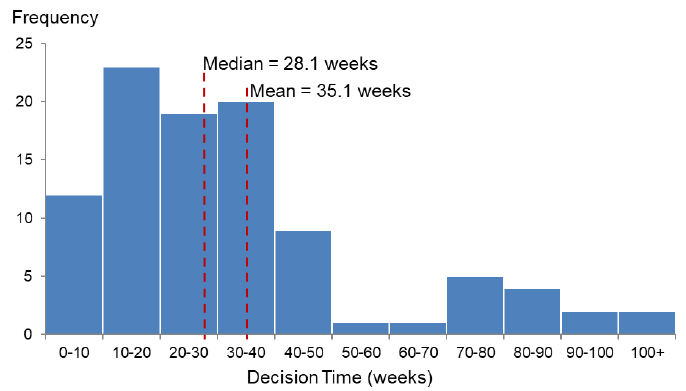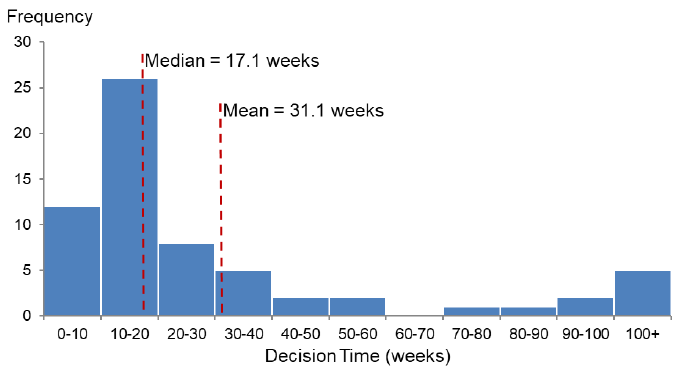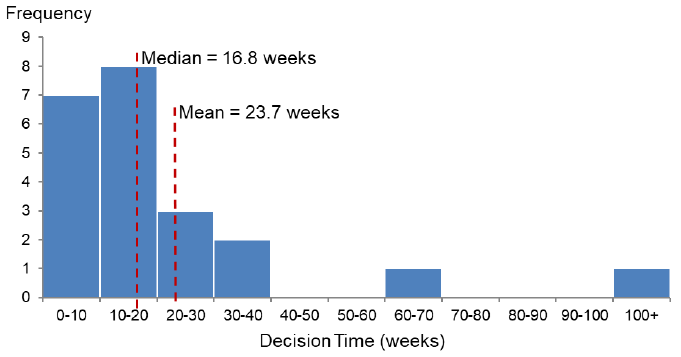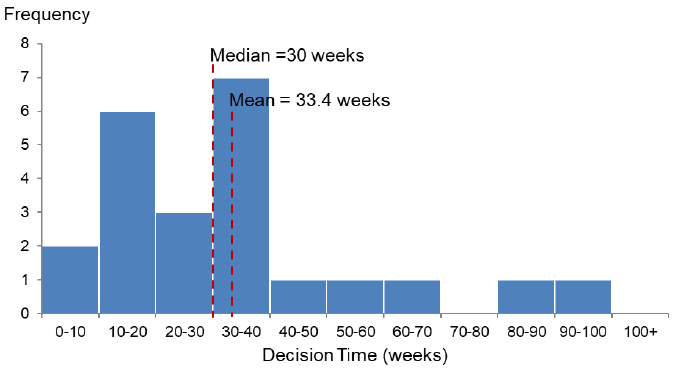Planning performance statistics: annual report 2018-2019
Annual statistics on planning decision-making and timescales for 2012-2013 to 2018-2019, based on quarterly data collected by the Scottish Government from Local and Planning Authorities as part of the Planning Performance Framework (introduced in 2012).
13. Annex
13.1. Distribution of decision times for major applications
Chart 46: Distribution of decision times for Major Housing developments 2018/19 (excludes one legacy case).

The vertical line at 35.1 weeks shows the mean (average) decision time for major housing developments. The second line at 28.1 weeks shows the median decision time. Decision times range from 2.6 weeks to 234.1 weeks. The chart shows that the mean decision time has been influenced by several lengthy decisions. Just over 60% of major housing applications were decided in a time quicker than the average of 35.1 weeks. 46% of major housing applications were decided within 6 months.
The five lengthiest decisions took 234.1 weeks (4.5 years), 145.1 weeks (2.8 years), 94.7 weeks (1.8 years), 92.7 weeks (1.8 years) and 86.4 weeks (1.7 years).
The lengthiest application was for planning permission in principle for a 7.6 hectare residential development in West Lothian. The application was approved.
Chart 47 shows the distribution of the decision times for major other developments. The category “other developments” includes any developments not falling wholly within any of the specific categories of development for minerals, housing, business & industry, waste management, electricity generation, fish farming. It includes, but is not limited to, retail, leisure and entertainment, education, healthcare, community facilities, transport interchanges, water and drainage developments and projects. It can also include mixed use projects.
Chart 47: Distribution of decision times for major other developments 2018/19 (excludes one legacy case).

The vertical line at 31.1 weeks shows the mean (average) decision time for major other developments. The second line at 17.1 weeks shows the median decision time. Decision times range from 3.4 weeks to 133.0 weeks. The chart shows that the average decision time has been influenced by several lengthy decisions. Almost three quarters of major other developments (72%) were decided in a time quicker than the average of 31.1 weeks and 67% were decided within 6 months.
The lengthiest decision, which was in Dumfries and Galloway, took 133 weeks (2.6 years) and was for planning permission in principle for residential and business units development at a former golf course. The application was approved.
Chart 48 shows the distribution of the decision times for major business and industry developments concluded in 2018/19. The category “ business and industry” developments include construction of a building or structure for any of the following: use as an office, for research and development of products or processes, for any industrial process or for use for storage or as a distribution centre. To be classed as major the gross floor space as a result of the development must exceed 10,000 square metres or the site area must exceed 2 hectares. Due to the small numbers of applications for major business and industry developments, average decision times are very variable.
Chart 48: Distribution of decision times for major business and industry applications, 2018/19

The vertical line at 23.7 weeks shows the mean (average) decision time for major business and industry developments. The second line at 16.8 weeks shows the median decision time. Decision times range from 1.6 weeks to 143.9 weeks. Almost 73% of major business and industry applications were decided in a time quicker than the average of 23.7 weeks with the just over 77% decided within 6 months.
The lengthiest decision, taking 143.9 weeks was in City of Edinburgh and is described as mixed use development including hotel and restaurant/bar with associated car parking, servicing, access arrangements and landscaping. The application was approved.
Chart 49 shows the distribution of the decision times for the remaining major applications that were concluded in 2018/19. These include applications for minerals, waste management, electricity generation and freshwater fish farming.
Chart 49: Distribution of decision times for remaining major applications 2018/19

The vertical line at 33.4 weeks shows the mean (average) decision time for the remaining major developments. The second line at 30.0 weeks shows the median decision time. Decision times range from 8.6 weeks to 97.6 weeks. The average decision time has been slightly skewed by a few lengthy decisions. Almost 57% of the remaining major applications were decided in a time quicker than the average of 33.4 weeks, 43% were decided within 6 months.
The lengthiest decision that took 97.6 weeks was an application for amendments to conditions for an application for a mineral development in South Lanarkshire involving extraction of sand and gravel with restoration to form a balancing pond, wetland, agriculture and grassland.
13.2. Statistics for other UK countries
Information and statistics on planning applications for the other UK countries can be accessed at the following links:
England: https://www.gov.uk/government/collections/planning-applications-statistics
Wales: http://wales.gov.uk/topics/planning/planningstats/?lang=en
Northern Ireland: http://www.planningni.gov.uk/index/tools/about-statistics.htm
Contact
Email: planstats@gov.scot
There is a problem
Thanks for your feedback